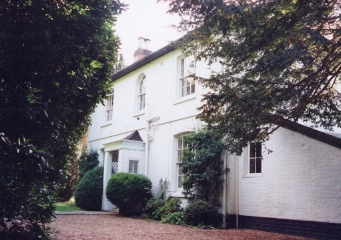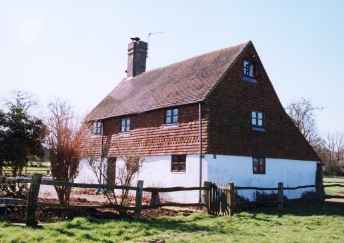Felcot Farm
|
|
|
Felcot Farm is situated on what was Hedgecourt Common, part of the Manor of Hedgecourt. This strip of common was purchased from the Gage family by Robert Clayton around 1677 and became part of the Manor of Bletchingley. The farm was originally known as Felcot and Forge Farms, implying that there were originally two properties there. It was situated on a set of crossroads across the common in the 18th Century. Shortly after 1856, the property was purchased by the Gatty family of Felbridge Place.
The Property is a small 16th century timber framed two bay farmhouse with a smoke bay at one end. An external chimney stack was added to the West end during the 17th century, and either side of the stack was infilled with stone to form part of the house. A further extension was put on the East end of the house and, at a later date, a brick lean-to extension was put on the East end and around the North side of the house.
|
 |
Gullege
|
|
|
Gulledge is situated West of East Grinstead and South East of Felbridge, on the East/West Ridge Way. It is a beautiful house at the end of a long lane with good views to the South.
The house is a timber framed property with a three-gabled Jacobean front with mullion windows that replaced the earlier exterior in 1609. The East and West ends are timber framed with plaster fronting and partly covered tiles. A feature is the three chimneys dating from Tudor times. They run the length of the house and the central one boasts an unusual star shape. The central stack indicates that the house was once T-shaped, possibly with a hall reaching to the full height of the house and having a gallery over the fireplace reached by spiral staircases. Horsham stone covers the roof beneath which are strong beams, heavy oak doors and spacious cellars.
Records show that Richard Alfrey, a medieval MP for East Grinstead, lived at Gulledge in 1365. The stone facade and family crest, added to the house in the 16th century, are attributed to Edward Alfrey. During restoration, wall paintings dating from 1550 were uncovered. There is also evidence that a settlement existed on the site in Mesolithic or early Neolithic periods of the stoneage, along with later Roman and Saxon times.
|
 |
Mill Cottages
|
|
|
The Mill Cottages at Hedgecourt were built to serve Hedgecourt watermill. They were once part of the Manor of Hedgecourt owned by the Gage family but were purchased in 1748 by Edward Evelyn and became part of the Felbridge Estate.
A watermill had operated at Hedgecourt since the 16th century although the cottages date from later. They were built in four stages, the oldest section being at the South end and dating from the 17th century. The occupier of this cottage was responsible for operating the sluice gate which regulated the flow of water to Wood Cock Hammer, or Wire Mill as it later became known. This section was extended in the 1700s with two more sections being added at a later date. They are partly tile hung and red brick under a tiled roof. The cottages were occupied up until the 1960s and then stood empty until the 1980s when they were refurbished and converted into two houses. In 2000 an application was made to convert the two houses into one.
Photograph courtesy of J Chewter
|
 |
Anns Orchard
|
|
|
Anns Orchard is situated on the Crawley Down Road and the land on which it is built was once part of the Manor of Imberhorne. The property was purchased by the Gatty family during the late 19th century and it then formed part of the Felbridge Place Estate. It was originally known as Five Oak Cottage, then Oak Cottage from the end of the 19th Century and eventually Anns Orchard.
The house is a fine example of the early 19th century style. The arched window at the front is known as a Venetian or Palladian window and was usually found on the first floor level. It was used to enhance many facades towards the end of the 18th century and early 19th century. Under the window there is a porch, built of the pagoda type that shows the influence of chinoiserie which was fashionable at the end of the 18th century. The property once had an orchard, now where the houses Harborne and Cherry Wood stand, and the outbuildings included a fruit store and stables.
A former owner of the property was the widow of Albert Chevalier the English comedian and music hall impersonator of the costermongering class of the late 19th century. He was famous for writing My Old Dutch and The Old Kent Road.
|
 |
Hophurst Farmhouse
|
|
|
Hophurst Farm is situated South of Felbridge on the East/West Ridge Way. The area of Hophurst dates from between 1250 and 1400 with evidence of woodland clearing dating from the 13th century. It was once part of the Manor of South-Malling, Lindfield. In 1590 Richard Alfrey is recorded as owner of Hoppers or Hophurst. It is believed to have got the name Hoppers from a previous tenant or owner by the name of Hopper.
The earliest part of the house is situated to the South of the chimney stack and was a three bay structure built between 1500 and 1550. The chimney, built between 1550 and 1600, replaced the smoke bay of the original building. The crosswing was also added at this time. The house is basically rectangular in shape, lying North to South. The crosswing is square in shape and positioned at the North end of the house, extending West. The roof is a hipped gabled structure hung with russet tiles. The house was originally timber framed but the walls on the West and South sides are covered with brick and hung with tiles. Much of the exposed timber framing found in the crosswing has brick infill to replace the originally plaster. The interior still retains wide oak floorboards and beams with mullioned windows.
|
 |
The Whitehouse
|
|
|
The Whitehouse was situated West of the village of Felbridge at Snow Hill. It was one time home to the family of Air Chief Marshall Hugh Caswell Tremenheere Dowding. In the 1986, on the death of Mrs K M K Dowding, the property was put up for sale in three lots. Plans were submitted to convert the property into twelve flats but these were turned down, and the conversion into three dwellings also fell through resulting in the demolition of the house which was replaced by two new properties, Green Acre and Crockstead.
The Whitehouse was a Victorian country house set in own grounds of about one and half acres, with a coach house, outbuildings and walled court yard. The house had an impressive hallway with a fine wrought iron staircase. The ground floor had a drawing room, dining room, front sitting room, two rear reception rooms, a front reception room, kitchen, dry cellar and five further rooms. The rooms had high ceilings, most with their original mouldings and ornate fireplaces. The staircase led to a half landing with etched glass rear window. On the first floor there were nine bedrooms, many with ornate fireplaces. There was a bathroom, shelved linen cupboards, and access to the attic.
Photograph courtesy of Mann & Co.
|
 |
Michaelmas Farmhouse
|
|
|
Michaelmas Farm is situated on what was Hedgecourt Common, part of the Manor of Hedgecourt. This strip of Common was purchased from the Gage family by Robert Clayton around 1677 and became part of the Manor of Bletchingley. The farm seems to have several name changes. In the middle of the 19th century it was known as Crouchers Orchard, after the Croucher family who were a well established family in the area and possible tenants. At the turn of the 20th century it was known as Miles Farm, after Thomas Miles who tenanted the property. Between 1982 and 1987 it had acquired its current name of Michaelmas Farm.
The property is a 16th century small timber framed farmhouse of two bays with a narrower smoke bay. A brick chimney was later inserted in the smoke bay area and the remainder of the bays ceiled over. There are many exposed timbers, including a heavy chamfered main ceiling beam. The timber framing had been infilled with brick and covered by weather boarding until 1989 when the weather boarding was replaced with clay hanging tiles. It has a high pitched tiled roof, with the later additions of two brick built extensions, one to the South East and one on part of the North West wall.
|
 |
Smugglers Cottage
|
|
|
Smugglers Cottage is situated West of the village of Felbridge at Snow Hill. There are many stories that the property dates back to 1385 and is linked to the smuggling trade. However, the building dares to 1685 and was the home of Drew Russell who took out a 200 year lease for 2s 6d per year.
The original part of the cottage dates is on the east. Over the years it has had brick additions and some of the timber framing has also been infilled with brick. It has leaded light windows and exposed timber under a clay tile roof. Internally there is a wealth of exposed oak beams and floor boards.
|
 |
Mount Cottages 1910
|
|
|
Mount Cottages are situated on Crawley Down Road and were built towards the end of the 19th Century. Orinally on the fringe of Hedgecourt Common, they were part of the Felbridge Place Estate when sold in 1919. They were then described as having a 'pleasing elevation, brick built and slate roofed. Each contains four rooms and a scullery. Additional land may be had, if desired, suitable for growing or any form of intensive gardening. These cottages would adapt themselves readily to alterations and additions which would render them very eligible as week-end retreats for busy workers.'
No.2 Mount Cottages has since been greatly extended and is now tile hung.
Photograph courtesy of K. Housman
|
 |
Imberhorne Farmhouse
|
|
|
The Manor of Imberhorne once belonged to Lewes Priory which was established in 1078. The old site of the Manor is at Imberhorne Farm, on the East/West Ridge Way After the Dissolution in 1537, Imberhorne was granted by Henry VIII to Thomas, Lord Cromwell who later passed it to William, Earl of Arundel. It later passed to the Crown and in 1560 was bought by Sir John Sackville in whose family it remained until 1872 when the estate was purchased by Dr T F Campbell. In 1877 the estate was sold to Edward Blount and his family retained it until 1955 when the Emmett family bought the farms of Imberhorne and Gulledge.
Imberhorne Farmhouse is a Georgian brick built house on a stone base with a slate roof. It has ten bedrooms, L shaped hall, office, sitting room, back lobby, bathroom, kitchen with larder, scullery, cellar and dairy.
|
 |









